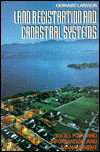Contents
Preface
Acknowledgments
1. Land information systems - tools for development
1.1 The need for land information
1.2 The concept of LIS
1.3 The need for coordination: structure
1.4 Parcel-based LIS
2. General aspects of land delimitation and documentation. Cadastre and land registration
2.1 Property rights and land delimitation
2.2 Justification for land documentation
2.3 The unit of record
2.4 Cadastres and legal land registers
3. Historical development of structure and function of cadastral and land registration systems
3.1 Early development
3.2 Development in the non-cadastral countries
3.3 Development in the cadastral countries
3.4 Different structures
4. Cadastral and land registration systems in Europe
4.1 Western Europe
4.2 Northern Europe
4.3 Southern Europe
4.4 Eastern Europe
4.5 General trends
4.6 Some European experiences
5. Land registration in English speaking countries
5.1 Land registration in England
5.2 Land registration in Australia
5.3 Land registration in other English speaking countries
5.4 Land registration in the United States
6. Benefits of cadastre and land register for development of rural and urban areas
7. Further benefits of cadastral and land registration systems. Calculating benefits
7.1 Improved basis for land assessment and taxation
7.2 Administrative benefits
7.3 Improving map production
7.4 Less litigation and less work for the courts
7.5 Easier transactions in land
7.6 Establishing a land market
7.7 Calculating benefits
8. Feasibility studies for establishing or improving a cadastral and land registration system
8.1 Investigation and presentation of basic facts
8.2 Analysis of existing problems and benefits of a new or improved system
8.3 Pilot studies
8.4 Cost estimates
8.5 Definition of principal goals
8.6 Choice of principal methods
8.7 Priorities and selection of areas
8.8 Definition of legal measures
9. Cadastral surveying
10. Adjudication
10.1 The legal role of adjudication
10.2 Different forms of adjudication
10.3 Adjudication by conversion of existing registers
10.4 The process of systematic adjudication
11. Registration
12. Special Problems
12.1 Individual or group registration?
12.2 Combined consolidation-registration
12.3 Squatter rights
13. Organization, automation, education
14. Progressive systems: ways of simplification
14.1 Progressive systems
14.2 Reduction of functions
14.3 Block units
14.4 Limited boundary delimitation
14.5 Simplified survey
14.6 Minimized field work
14.7 Provisional registers
14.8 Selectivity
14.9 Axes of variation
Summary
Appendix A: Land unit identifier
Appendix B: Two examples of automation: Sweden and Canada
References and bibliography
Index

